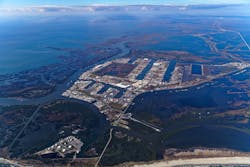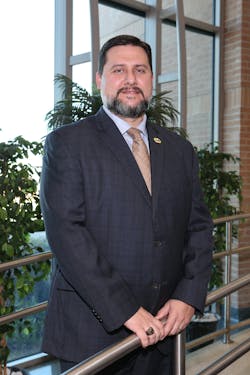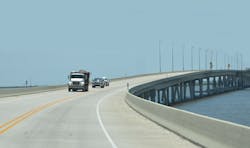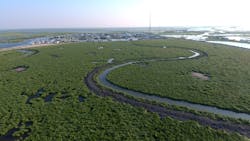Port Fourchon: Ready today, ready for tomorrow
GLPC celebrates 60 years in business
Judy Murray, Contributing Editor
According to Chett Chiasson, executive director of the Greater Lafourche Port Complex, it is an exciting time to be working in Port Fourchon.
“The Port is celebrating 60 years of serving the Gulf of Mexico (GoM), and we are working on plans that will position it well for the future,” he said.Expansion work continues on Slip C, which will add 2,500 ft (762 m) of waterfront. “We’re also doing the final dredge of Slip D that will increase the water depth to 27 ft (8.2 m),” Chiasson said, noting the slip will be fully dredged this year and ready for development.
Chiasson also is pleased with the progress the port commission has been made with mitigation and restoration through the years. He pointed to the Maritime Forest Ridge, a now 6,000 linear foot ridge that has been in place for more than 12 years, as an example. Chenier ridges and maritime forests are physically and ecologically important to the coast. In addition to their function topographically in slowing storm surges, they are the critical habitat for more than 338 migrating bird species that travel along the Mississippi Flyway each spring and fall. Working together, the Barataria-Terrebonne National Estuary Program, Gulf of Mexico Program, Gulf of Mexico Foundation, National Oceanic and Atmospheric Administration, Louisiana Department of Natural Resources, USDA National Resources Conservation Service, Shell and the Port have restored the ridge that had eroded away over the years. Also, the port has restored more than 1,000 acres of wetlands with material beneficially used through the slip and channel hydraulic dredging process.
Investing in airport expansion
Restoration and refurbishment are going on in many areas around the Port, including projects at the South Lafourche Leonard Miller, Jr. Airport. Updates and upgrades are important, Chiasson said, because the number of people going through the airport continues to grow as does the facility’s impact on the local economy.
Last year, more than 130,000 people transited the airport, and according to statistics from the Louisiana Department of Transportation and Development (LaDOTD), the airport ranked fourth in the state in total economic benefits in 2019, with a net output of $97,628,000. This constitutes an increase of more than $25 million since the last impact assessment was conducted in 2015. In 2019, the airport employed 500 people, compared to 380 in 2015, with an $18 million payroll.
While these numbers are impressive, Chiasson said there is still room for growth. “The Airport Corridor, as much as has been done, is a clean slate for attracting new business and economic development,” he said, and improved access created by the new airport road will facilitate new investment.
A grant from the Federal Economic Development Administration, money from the Port Commission, and contributions by the parish government, amounting to $1.2 million have gone to rebuilding the sub-basin, raising and paving the airport road and completing the intersection at LA 308. Meanwhile, an airfield drainage project has been completed, and design work is being finalized for a new hangar.
The next big thing will be a $35 million project for a three-lane bridge across Bayou Lafourche, connecting highway LA 308 with LA 1 and an access road that will provide a direct connection to the airport. This will be funded by a $16.4 million federal BUILD Grant, $9.3 million provided by the state and the balance coming from the Parish and the Port Commission.
The first two phases – repaving the road and constructing the intersection – are finished, according to Chiasson, and the next phase is being designed. “It is 60% complete and will be ready for bid by September,” he said. Construction is expected to begin in the spring of 2021.
“This is only one of the construction projects going on here,” Chiasson said. “We are also making progress on LA 1, the two-lane highway that supports Grand Isle, Port Fourchon and the Louisiana Offshore Oil Port (LOOP), the only deepwater oil port facility in the United States.”
Improving access with LA 1
Henri Boulet, executive director of the LA 1 Coalition, is excited about the progress being made on the highway LA 1 initiative. “The LA 1 project has great momentum going into 2020,” he said, noting that the coalition made significant progress last year, in particular with the Louisiana state legislature approving $150 million of funding for Phase 2 of the project, which is the 8.3 mi (13.4 km) of elevated highway from Golden Meadow south to Leeville.
“The state’s 1999 commitment makes up 33% of what we believe we need for Phase 2,” Boulet said, “and we have a second major commitment from the Port for $25 million for the project over a five-year period. We also are asking industry operators that rely on Port Fourchon to support their Gulf of Mexico operations to provide a multi-million-dollar collective industry pledge.”
With a significant portion of the funding secured, the LA 1 Coalition worked with the LaDOTD to file an application with the US DOT INFRA Grant Program for $185 million to match other commitments.
Boulet said there is strong agreement among local, state and federal stakeholders that this project is critically important. It not only will enable safe entry and exit from the Port, it will allow access to Grand Isle, the only inhabited barrier island offshore Louisiana.
“People have homes on Grand Isle,” Boulet said. “It’s our version of Martha’s Vineyard, and it draws thousands of tourists each year to beautiful beaches, crabbing grounds and speckled trout fishing.”
With the present state of LA 1, access is compromised any time tides are unusually high or inclement weather forms in the GoM. When the island has to be evacuated, the poor condition of the current low-lying road poses evacuation challenges.
“LA 1 also provides the only access to barrier island and marsh restoration projects like the Belle Pass-Golden Meadow Marsh Creation Project, which will create 23,200 acres of marsh along the LA 1 corridor to provide new wetland habitat and restore degraded marsh,” Boulet said.
Coastal restoration is vital in south Louisiana, where the coastline is shrinking. Although work is ongoing to rebuild as much of the wetlands as possible to sustain and maintain the coast, limited access drives up the cost of these projects. “The lack of a reliable road impacts restoration costs because project delays from compromised or delayed road access affect cost,” Boulet says.
The seafood industry also relies on LA 1 to get to the fishing grounds and to move their catch to market. “Approximately 7.8 million pounds of seafood, amounting to $17 million, moves on this road every year,” he said, “but when the road is closed, seafood docks can’t get their catch to processing facilities. It’s a critical road for a lot of reasons.”
In fact, there are far-reaching repercussions when LA 1 is impassable. Each day LA 1 is closed costs $46 million in oil and gas production and $528 million in GDP.
“The cost of improving this road pales in comparison to what is lost when the road is closed,” Boulet said. “It is clear that the proposed improvements need to be done.”
Expanding deepwater capabilities
Improving access is critical for multiple areas, including Fourchon Island, another significant project that is in progress. Investment in the Fourchon Island Project will provide Port Fourchon greater access to the GoM by increasing inner harbor depths to accommodate larger vessels, rigs, and platforms. When completed, the channel at Belle Pass will be 50 ft (15.2 m) deep, with the dredged material going to the Barataria-Terrebonne basin.
“We will be able to create more than 4,700 acres of marsh over the years with this project,” Chiasson said. “The port has constructed more than 1,000 acres of wetlands and developed another 1,000 acres of land since 2000.” Those efforts will increase during the next phase of development.
The plans for Fourchon Island are ambitious. In late January, the Port filed a permit to develop a slip on the island and an application for a federal grant from MARAD to rebuild the Fourchon Bridge to provide road access to the island.
“The previous pedestal bridge wasn’t safe,” Chiasson said. “It had to be removed because it couldn’t be closed. It is over a navigable waterway, so it needed to be opened, but it couldn’t be left open because it presents a safety hazard in its open state.”
Chiasson said the bridge cost is estimated at $24 million and is hoping for $14 million in federal funding, but even if the grant does not come through, he hopes the project will proceed. “We absolutely need access with or without the grant. The island is only accessible by boat today. Having a bridge is vital not only for future development but for safety reasons,” Chiasson said, pointing out that there are pipelines running through the beach head on the island and a facility manned by workers.
Early in 2019, GLPC submitted an addendum to its original feasibility report for plans to increase the water depth around the island. The goal is to eventually dredge to 50 ft (15.2 m) in Belle Pass, then 30 ft (9.1 m) through Bayou Lafourche into Floatation Canal and into the northern expansion at the port. This water depth will permit future development on Fourchon Island, enabling GLPC to carry out its plans to build a deepwater rig, repair and refurbishment facility.
“Having a deepwater facility here would be enormously beneficial for operators,” Chiasson said, “but the environmental benefits on the back end – creating habitat and repairing the coastline that has been lost over the years – are even more important to us as than the economic side.”
Getting LNG in the mix
Adding to the capabilities at Port Fourchon is a priority, Chiasson said. “We need diversification, and we are excited about adding LNG facilities to our offering.”
Fourchon LNG LLC is making progress on the LNG development, which is intended to supply clean fuel to the company’s power generation assets being developed in the Caribbean and Asia. At the January GLPC Board Meeting, Energy World Group, the parent company of Fourchon LNG LLC, provided a status report on the new LNG facility, the first phase of which will require an estimated $888 million to build.
Construction is expected to begin in mid-2021 on Phase 1 – an LNG train with 2 million tons per year (MTPA) capacity, a storage tank, and associated marine facilities for loading and exporting LNG. The facility is expected to be ready for commercial operation by mid-2023. Phase 2 is expected to begin commercial operation in mid-2025, increasing capacity by 3 MTPA and providing a second LNG tank.
The project management team is in place, as are the environmental and legal advisors, and key equipment and technology suppliers have been selected. Plans and strategies have been completed, and work is beginning on the next steps, which include the final filing of resource reports, FERC approval, formalizing gas supply agreements and project funding.
“This is a great addition to the suite of vessel services that are offered by our tenants and greatly enhances our capability and versatility,” Chiasson said.
Continuing the journey
As the port celebrates 60 years in business, Chiasson and his team are working with the elected Board of Commissioners to chart the way forward. “We want to be a leader into the future,” he said. “We are always looking for the next best value additions to our Port.”
With lower barrel prices constituting the new normal, it is more important than ever to plan and invest wisely.
“Sixty years ago, the Port was just an idea,” Chiasson said. “Today, it’s critical to Gulf of Mexico oil and gas operations, and the environmental work we’ve done is contributing to the wellbeing of our community and industry. Without the oil and gas industry, the area Port Fourchon sits on would have been washed away. We take a lot of pride in what we have accomplished here.”
Prudent investment at the Port will allow it to continue to serve the needs of the industry and the community, but its continued success really rests on the companies that call the Port home, Chiasson said.
“We’re very thankful to our tenants. Without their loyalty and their commitment to providing world-class service to customers, we wouldn’t have a port. They made the decision to invest in Port Fourchon, and we’re grateful for that,” he said. •




